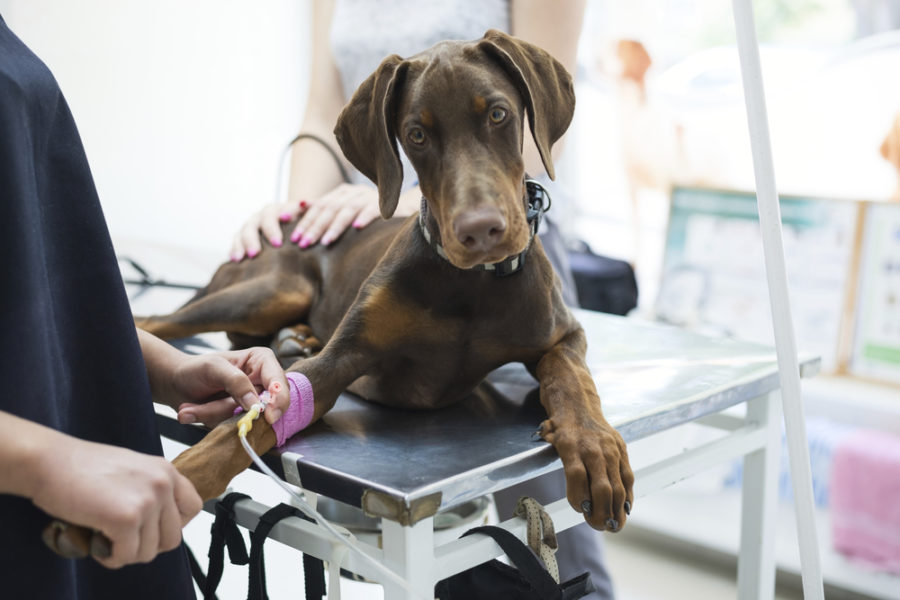De-bunking surgery myths to help you feel more at ease at the thought of your animal companion going under the knife.
When Barb discovered a lump on her golden retriever’s side, it took her a while to bring it to the veterinarian’s attention. Why? “I was scared,” she admits. “I didn’t want him to undergo an operation. I had to drum up some courage before I took him to the vet.” As it turned out, the lump was benign, but if it hadn’t been, Barb’s fear and hesitation could have had serious consequences. The truth is, most dogs will need one or more surgical procedures at some point in their lives. It could be for spaying or neutering, dental work, or a tumor or wart removal. People often have anxieties about subjecting their dogs to operations. This article addresses six of the most common myths associated with surgery in dogs.
Myth #1: “My dog is too old for surgery.”
I hear this way too often. How sad that our senior citizens of the canine world are denied proper medical care because someone thinks they’re “too old.” No dog is too old to receive necessary surgery.
Of course, there may be other factors involved besides age. For example, a 15-year-old Labrador with hip dysplasia and arthritis might be a candidate for total hip replacement surgery. But his person may decide against it due to the cost, the postoperative physical therapy required, and the fact that the dog has already reached the end of his life expectancy. But the dog is not “too old” to have surgery, even if it might not be the preferred option due to his age.
In my practice, most of my surgical patients are ten years of age and older, and many are 15 years of age and older. These animals routinely receive surgery for dental work and the removal of various skin growths, including tumors. None are “too old” for this type of care. With modern anesthetic drugs and monitoring, and analgesic (pain-relieving) medications, all these animals do very well and have no negative post-operative effects.
Myth #2: “All tumors should be removed.”
Some veterinarians recommend that people have any and all growths on their dog removed. While I’m a big fan of early diagnosis of cancerous tumors, I don’t believe in doing surgery just for the sake of doing surgery. Here are the guidelines I use to help people determine if and when a growth or tumor should be removed:
- Any growth large enough to aspirate with a small needle and syringe should be aspirated, and the contents of the aspirate examined microscopically.
- If the tumor is a benign lesion, such as a fatty tumor or cyst, I may use herbal or homeopathic therapy to help shrink it. However, if it is large, or is growing or bothering the dog, I will schedule surgery to remove it.
- If the aspirate shows a malignant cancer, the growth is removed surgically.
- If the aspirate is non-diagnostic, the growth is removed surgically and biopsied.
- Following surgical removal of any lesion that is cancerous, or for which a diagnosis was not made using aspiration cytology, the lesion is sent to a pathologist for further microscopic examination and definitive diagnosis.
My personal feeling is that most of the time, it is a waste of money to have small benign lesions removed. My one exception would be if the dog is scheduled to have another anesthetic procedure such as a dental cleaning done, during which the lesion can be removed. I try to avoid surgery whenever it’s not necessary in order to spare people the expense and to prevent subjecting dogs to unnecessary anesthetic procedures.
Myth #3: “It’s okay to wait for a tumor to grow before removing it.”
Again, it is okay to wait and watch benign lesions before removing them, as they rarely grow. However, unless an aspirate of the tumor has been examined microscopically, I believe all tumors should be viewed as potentially malignant until proven otherwise. There is no reason to wait and watch cancer grow when tumors can easily be removed when they are small. Removing tumors when they are small may actually cure the cancer without the need for chemotherapy or radiation. Therefore, unless we know that the tumor is benign and unlikely to hurt the dog, it should be removed rather than watching it grow to potentially harm or kill the animal.
Myth #4: “Analgesic medicine is not necessary for most surgeries.”
Analgesic (painkilling) medication should be used whenever we know or suspect a dog may feel pain. For the majority of surgeries, some type of analgesic medication should be given. The best way to use it is through pre-emptive analgesia and multimodal analgesia.
- Pre-emptive analgesia means giving the medication before pain occurs – that is, prior to surgery.
- Multimodal analgesia means giving the dog several different classes of medication, such as NSAIDs and opioid medications, and even local anesthetics, which work on different biochemical pathways to relieve pain. Of course, naturopathic medications that assist in healing, such as herbs and homeopathics, can be included in the multimodal approach to analgesia.
Following surgery, additional analgesic medications should be given at home for several days (or longer, depending on the procedure) to assist in healing. One word of caution: many veterinarians, in an attempt to reduce the costs of a surgical procedure, either do not use any (or enough) analgesic medications or offer it as an option prior to the procedure. I personally believe this is malpractice and encourage you not to subject your companion to any surgical procedure in which some type of analgesic medication is not used.
Myth #5: “The lowest cost provider should be the one you choose for your dog’s surgery.”
There are veterinarians who call themselves “low cost”. While I appreciate the desire and need for people to save money, it’s important that cutting costs doesn’t reduce the quality of care the dog receives, or put his health or life at risk.
There are only so many ways to cut costs with surgery. Usually, this requires “leaving something out”. If that “something” is essential to your dog’s well being, it could possibly affect him in a negative way. Some low-cost veterinarians reuse needles, syringes, and scalpel blades (sterilizing them between procedures, but not using fresh new ones). Some use less expensive anesthesia, which makes it more challenging to control a dog’s vital signs. Others do not have animals monitored by a technician or machine during surgery.
If you’re considering having surgery for your dog, no matter how “routine” the procedure may seem, find out ahead of time just what is or is not included in the price you are quoted.
Chances are, your dog is going to need at least one operation in his lifetime. Arming yourself with the right information will help you make the best possible choice for his healthcare, and give you better peace of mind.

